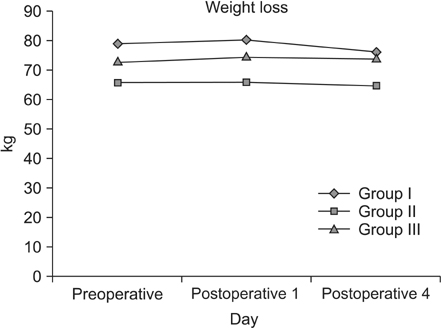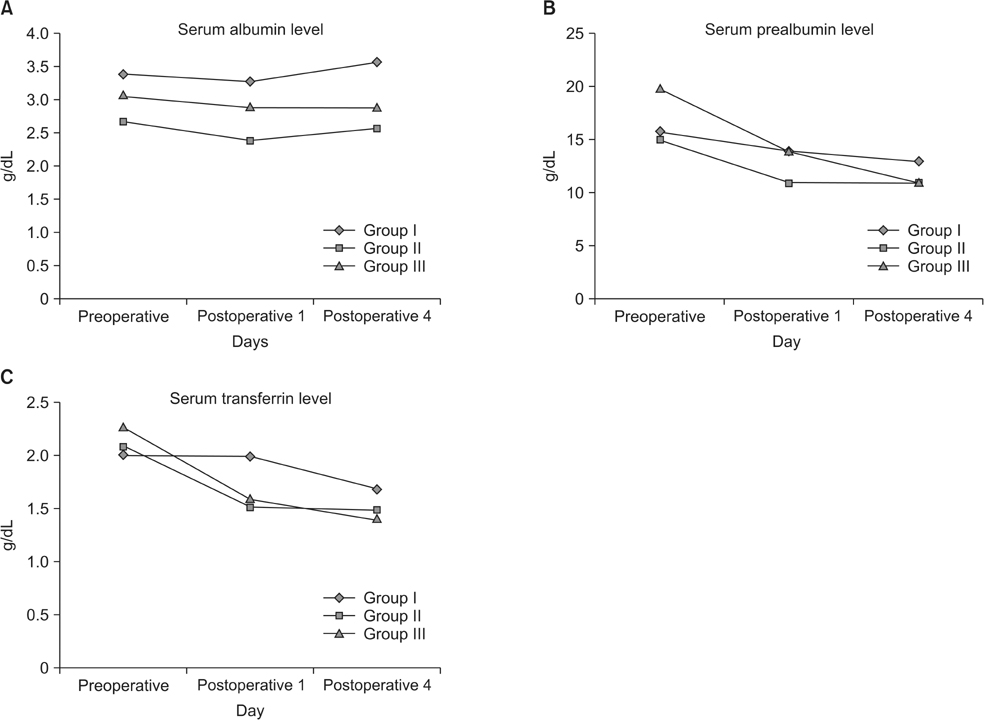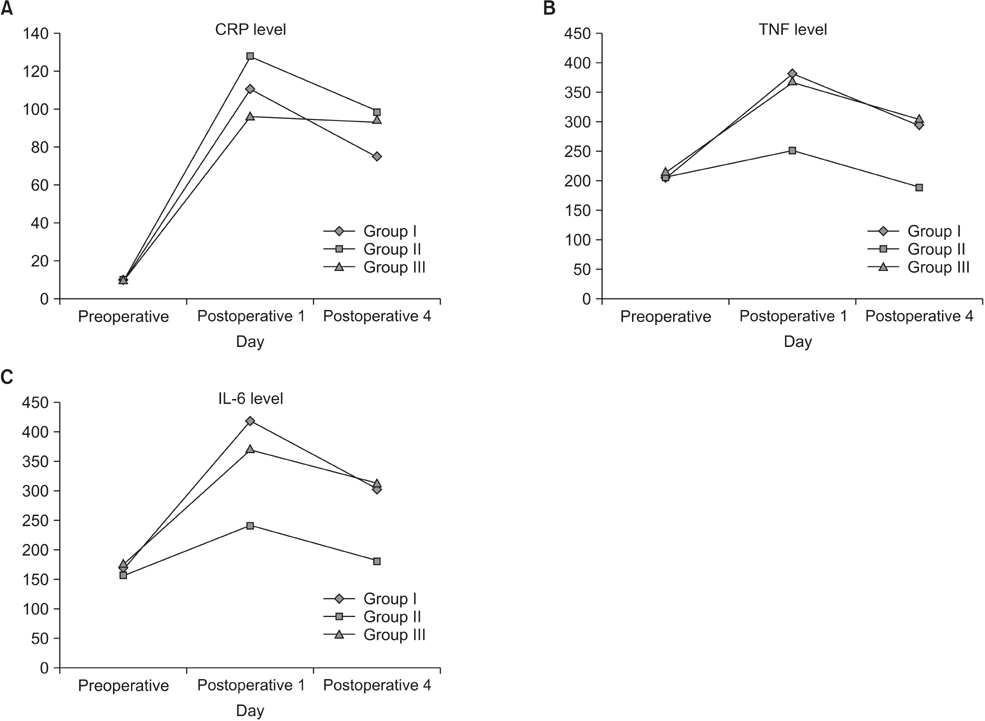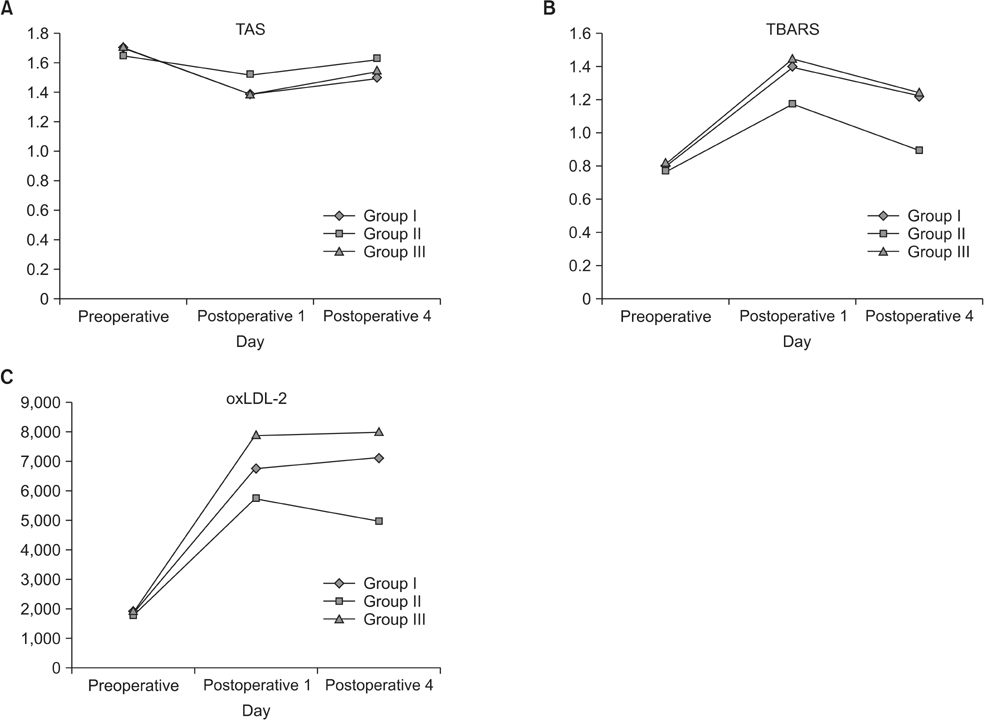Ann Surg Treat Res.
2016 Dec;91(6):309-315. 10.4174/astr.2016.91.6.309.
Effects of postoperative parenteral nutrition with different lipid emulsions in patients undergoing major abdominal surgery
- Affiliations
-
- 1Department of General Surgery, Ankara University School of Medicine, Ankara, Turkey.
- 2Ankara Numune Education and Research Hospital, Ankara, Turkey. karacaahmetserdar@gmail.com
- 3Ankara University School of Medicine Nutrition Team, Ankara, Turkey.
- 4Department of Biostatistics, Ankara University School of Medicine, Ankara, Turkey.
- KMID: 2360391
- DOI: http://doi.org/10.4174/astr.2016.91.6.309
Abstract
- PURPOSE
This study was designed to investigate the effects of total parenteral nutrition (PN) using different lipid emulsions in patients undergoing major abdominal surgery.
METHODS
Fifty-two patients were randomized to receive soybean oil + medium chain triglycerides (MCT) (group I), soybean oil + olive oil (group II), soybean oil + olive oil + fish oil (group III) as a lipid source. PN was started on postoperative day 1 and patients were maintained on PN for a minimum period of 4 days. Laboratory variables (CRP, prealbumin, transferrin) were measured before surgery and on postoperative days.
RESULTS
Three treatment groups were included in the study. Patients in group I received long chain triglycerides (LCT) + LCT/MCT emulsion (%75 LCT + %25 LCT/MCT); Patients in group II received olive oil based emulsion (80% olive oil + 20% soybean oil, ClinOleic); Patients in group III received fish oil in addition to olive oil based emulsion (%85 ClinOleic + %15 Omegaven; Fresenius Kabi). The following 14 parameters were assessed: body weight, CRP, prealbumin, transferrin, tumor necrosis factor-α, interleukin-6, total antioxidant status, thiobarbituric acid reactive substances, oxidized low density lipoprotein-2, complete blood cell, international normalized ratio, D-dimer, activated partially thromboplastin time, prothrombin time. All other parameters showed no differences among the groups.
CONCLUSION
The results of our trial demonstrate a potential beneficial effect of soybean oil/olive oil based lipid emulsions for use in PN regarding inflammatory response and oxidant capacity in the treatment of patients.
MeSH Terms
-
Blood Cells
Body Weight
Emulsions*
Fish Oils
Humans
Interleukin-6
International Normalized Ratio
Necrosis
Olive Oil
Parenteral Nutrition*
Parenteral Nutrition, Total
Prealbumin
Prothrombin Time
Soybean Oil
Soybeans
Thiobarbituric Acid Reactive Substances
Thromboplastin
Transferrin
Triglycerides
Emulsions
Fish Oils
Interleukin-6
Olive Oil
Prealbumin
Soybean Oil
Thiobarbituric Acid Reactive Substances
Thromboplastin
Transferrin
Triglycerides
Figure
Cited by 1 articles
-
Safety and efficacy of peripheral nutrition fluid (MG-TNA®) in patients undergoing surgery for hepatobiliary and pancreatic disease: Results of a phase 4 trial
Young-Dong Yu, Jae-hyun Han, Sung-Won Jung, Dong-Sik Kim
Ann Hepatobiliary Pancreat Surg. 2019;23(2):133-137. doi: 10.14701/ahbps.2019.23.2.133.
Reference
-
1. Calder PC. Immunonutrition in surgical and critically ill patients. Br J Nutr. 2007; 98:Suppl 1. S133–S139.2. Wirtitsch M, Wessner B, Spittler A, Roth E, Volk T, Bachmann L, et al. Effect of different lipid emulsions on the immunological function in humans: a systematic review with meta-analysis. Clin Nutr. 2007; 26:302–313.3. Berdanier CD. Role of membrane lipids in metabolic regulation. Nutr Rev. 1988; 46:145–149.4. Mantzioris E, James MJ, Gibson RA, Cleland LG. Differences exist in the relationships between dietary linoleic and alpha-linolenic acids and their respective long-chain metabolites. Am J Clin Nutr. 1995; 61:320–324.5. Calder PC. Dietary fatty acids and the immune system. Nutr Rev. 1998; 56(1 Pt 2):S70–S83.6. Pomposelli JJ, Bistrian BR. Is total parenteral nutrition immunosuppressive? New Horiz. 1994; 2:224–229.7. Mascioli EA, Bistrian BR, Babayan VK, Blackburn GL. Medium chain triglycerides and structured lipids as unique non-glucose energy sources in hyperalimentation. Lipids. 1987; 22:421–423.8. Sala-Vila A, Barbosa VM, Calder PC. Olive oil in parenteral nutrition. Curr Opin Clin Nutr Metab Care. 2007; 10:165–174.9. Driscoll DF, Bacon MN, Bistrian BR. Physicochemical stability of two types of intravenous lipid emulsion as total nutrient admixtures. JPEN J Parenter Enteral Nutr. 2000; 24:15–22.10. Faist E, Wichmann MW, Kim C. Immunosuppression and immunomodulation in surgical patients. Curr Opin Crit Care. 1997; 3:293–298.11. Wachtler P, Konig W, Senkal M, Kemen M, Koller M. Influence of a total parenteral nutrition enriched with omega-3 fatty acids on leukotriene synthesis of peripheral leukocytes and systemic cytokine levels in patients with major surgery. J Trauma. 1997; 42:191–198.12. Weiss G, Meyer F, Matthies B, Pross M, Koenig W, Lippert H. Immunomodulation by perioperative administration of n-3 fatty acids. Br J Nutr. 2002; 87:Suppl 1. S89–S94.13. Wichmann MW, Thul P, Czarnetzki HD, Morlion BJ, Kemen M, Jauch KW. Evaluation of clinical safety and beneficial effects of a fish oil containing lipid emulsion (Lipoplus, MLF541): data from a prospective, randomized, multicenter trial. Crit Care Med. 2007; 35:700–706.14. Tsekos E, Reuter C, Stehle P, Boeden G. Perioperative administration of parenteral fish oil supplements in a routine clinical setting improves patient outcome after major abdominal surgery. Clin Nutr. 2004; 23:325–330.15. Liang B, Wang S, Ye YJ, Yang XD, Wang YL, Qu J, et al. Impact of postoperative omega-3 fatty acid-supplemented parenteral nutrition on clinical outcomes and immunomodulations in colorectal cancer patients. World J Gastroenterol. 2008; 14:2434–2439.16. Ruiz-Gutierrez V, Muriana FJ, Guerrero A, Cert AM, Villar J. Plasma lipids, erythrocyte membrane lipids and blood pressure of hypertensive women after ingestion of dietary oleic acid from two different sources. J Hypertens. 1996; 14:1483–1490.17. Yaqoob P, Knapper JA, Webb DH, Williams CM, Newsholme EA, Calder PC. Effect of olive oil on immune function in middle-aged men. Am J Clin Nutr. 1998; 67:129–135.18. Moussa M, Le Boucher J, Garcia J, Tkaczuk J, Ragab J, Dutot G, et al. In vivo effects of olive oil-based lipid emulsion on lymphocyte activation in rats. Clin Nutr. 2000; 19:49–54.19. Esterbauer H, Gebicki J, Puhl H, Jurgens G. The role of lipid peroxidation and antioxidants in oxidative modification of LDL. Free Radic Biol Med. 1992; 13:341–390.20. de la Puerta R, Ruiz Gutierrez V, Hoult JR. Inhibition of leukocyte 5-lipoxygenase by phenolics from virgin olive oil. Biochem Pharmacol. 1999; 57:445–449.
- Full Text Links
- Actions
-
Cited
- CITED
-
- Close
- Share
- Similar articles
-
- Early Effective Parenteral Nutrition for Preterm Infants
- Efficacy of monounsaturated fatty acids in reducing risk of the cardiovascular diseases, cancer, inflammation, and insulin resistance: a narrative review
- Lipofundin(R) MCT/LCT 20% increase left ventricular systolic pressure in an ex vivo rat heart model via increase of intracellular calcium level
- Perioperative nutritional therapy for surgical patients
- Analysis of Adverse Reactions Associated with Parenteral Nutrition Use in Korea





